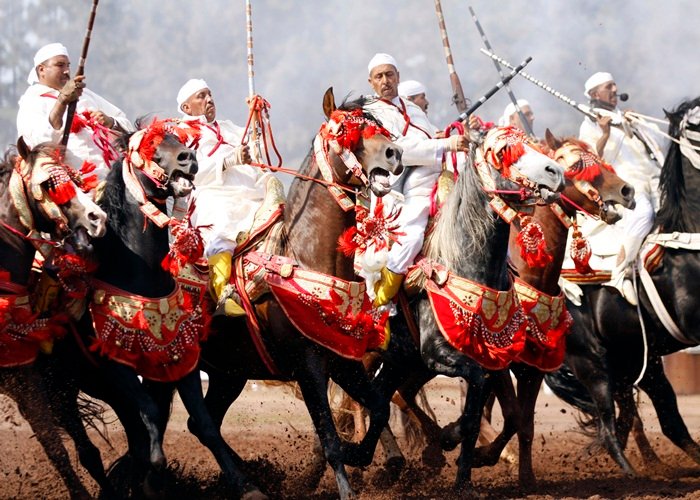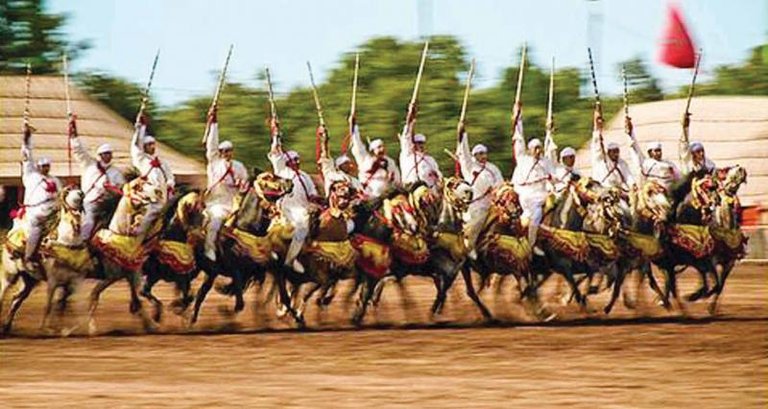مع فصل الصيف يشتد اهتمام المغاربة بفن التبوريدة في الحفلات والمهرجانات والمواسم، التي تفوق المائة، حتى أن هذا الفن الفرجوي يكاد يكون العلامة المميزة لهذه الاحتفالات، خاصة أنه يختلط بكثير من الطقوس الطافحة بالرموز والدلالات التراثية العميقة.

With the summer, Moroccans are more interested in the art of Taboridia in concerts, festivals and seasons, which are more than 100, so that this art of vulva is almost the hallmark of these celebrations, especially since it is mixed with many rites with symbols and deep cultural connotations.
وترجع فنون الفروسية المغربية التقليدية أو "التّبُوريدَة" إلى القرن الخامس عشر الميلادي، وتعود تسميتها إلى البارود الذي تطلقه البنادق أثناء الاستعراض، وهي عبارة عن مجموعة من الطقوس الاحتفالية المؤسسة على أصول وقواعد عريقة جدا في أغلب المناطق المغربية، وخصوصا في المناطق ذات الطابع البدوي
The traditional Moroccan equestrian or "Taboridian" art is due to the fifteenth century AD, and is referred to as gunpowder during the parade, a collection of ceremonial rituals based on very ancient origins and rules in most Moroccan regions, especially in nomadic areas
وتتعدد المناسبات التي يحتفل بها المغاربة والتي تتخللها عروض من فن "التبوريدة" مثل حفلات الأعراس والمواسم والعقيقة والختان. وتمثل هذه الوصلات الفنية المغرقة في الرمزية اختزالا للطقوس الكرنفالية والفلكلورية لدى المغاربة التي ينسجم فيها اللباس مع الغناء والرقص والفروسية والأضحية والنار.. في سياق متناغم.
Several occasions are celebrated by Moroccans, interspersed with performances of the art of "Tiborida", such as weddings, seasons, arraignment and circumcision. These artistic links embodying the symbolism are a reduction of the carnival and folkloric rites of the Moroccans, in which the dress is intertwined with singing, dancing, equestrian, sacrifice and fire in a harmonious context.

تراث عريق
وتعد "التبوريدة" طقسا احتفاليا وفلكلوريا عريقا لدى المغاربة، وهي ليست وليدة العصر، لذلك باتت مرتبطة في أذهانهم بتقاليد وعادات تجمع بين المقدس والدنيوي، حيث تصاحبها مجموعة من الأغاني والمواويل والصيحات المرافقة لعروضها والتي تحيل على مواقف بطولية، وهي تمجد البارود والبندقية التي تشكل جزء مهما من العرض الذي يقدمه الفرسان، خاصة عندما ينتهي العرض بطلقة واحدة مدوية تكون مسبوقة بحصص تدريبية يتم خلالها ترويض الخيول على طريقة دخول الميدان، وأيضا تحديد درجة تحكم الفارس بالجواد.
وتشكل التبوريدة جزءا لا يتجزأ من التراث المغربي الأصيل الذي يعيد الذاكرة الشعبية والمتفرجين في مناسبات عديدة إلى عهود مضت، وهنا يمكن القول إن المغاربة الذين يمتلكون الخيول المدربة على التبوريدة هم من علية القوم في القبيلة وأصحاب خبرة وشأن عظيم ونخوة وقيمة في البلاد.
وضمن استعراضاتها لا تستطيع فرق الخيالة "البواردية" العمل دون أن تصاحبها أهازيج شعبية مثل "الطقطوقة" الجبلية ووصلات "النفار" وفرق "الطبالة" و"الغياطة" و"الكوامانجية"، وهي عناصر متلازمة في كل الحفلات العمومية والمواسم والمهرجانات الشعبية.
Ancient heritage
The Tauborida is a ceremonial and folkloric ritual for the Moroccans, and it is not the origin of the age. Therefore, they are associated with traditions and customs that combine the sacred and the mundane, accompanied by a collection of songs, mantras and shouts accompanying their performances, which reflect heroic attitudes. No matter what the offer of the knights, especially when the end of the show with one shot, which will be preceded by training sessions during which horses are tame to enter the field, and also determine the degree of control knight horse.
Tauridism is an integral part of the original Moroccan tradition, which brings back popular memory and spectators on many occasions to the past. Here, it can be said that the Moroccans who own the horses trained on Taborida are of the people of the tribe and have experience, greatness, brotherhood and value in the country.
As part of its reviews, the "Pioneer" cavalry teams can not work without being accompanied by popular songs such as the mountainous "catacombs", "nafar", "drumming", "gaita" and "quamnagia", which are common in all public events, seasons and folk festivals.
فن مهدد
ويؤدي فن "التبوريدة" فرسان، قد يصل عددهم إلى مائة فارس، ينتظمون في دوائر حول شيخ مسن، يشكل رئيس فرقة التبوريدة يدعى "العلام"، ويبدؤون في الدوران حول الحلقة، وهم يرددون عبارات متنوعة تذكر بـ"حَرْكة الجهاد"، ثم يطلقون نيران بنادقهم في اتجاه السماء أو في اتجاه الأرض تابعين في ذلك إشارة "العلاّم"، وكلما كانت الطلقة منسجمة وموحدة، كان اللغط والتصفيق والزغاريد، وكلما كانت الطلقات متناثرة ومشتتة غضب العلام ومعه الجمهور.
ويحتاج فن "التبوريدة" إلى تدريب كبير ومستمر من أجل ترويض الجواد على طريقة دخول الميدان والعدو في انسجام تام مع باقي الخيول. ويكون "العلام" هو المسؤول عن تنظيم الفرقة عند خط البداية وإعطاء إشارة الانطلاق وإشارة الوقوف الذي يعد بمثابة سيطرة على الجواد، وتكون الإشارة النهائية بإطلاق الرئيس طلقة من بندقيته التقليدية، وبعد ذلك يعود الفرسان إلى نقطة الانطلاق ليكرّروا العملية من جديد، ويستعرضوا مهاراتهم أمام الجمهور.
وللحفاظ على اللياقة البدنية للفرس، يحتاج صاحبه إلى ترويضه باستمرار، والعناية به وفق برنامج مضبوط وصارم من العلف والتدريب والغسل، وإلا فإنه يفقد بسرعة لياقته وقدرته على المنافسة، وتتطلب هذه العمليات من صاحب الفرس إمكانيات مادية كبيرة ترهق كاهله بميزانية ترتفع بالتدريب مع اشتعال أسعار العلف وتعاقب سنوات الجفاف.
ويتخوف كثيرون من انقراض هذا الفن العريق، خاصة أن من يحافظ على هذا التراث هم من الفلاحين البسطاء الصّامدين في البوادي في غياب أي دعم من المؤسسات الرسمية التي يفترض فيها السهر على تقديم المساعدات لهؤلاء بغية الحفاظ على التراث الرمزي للبلاد، خاصة في الأيام العصيبة، وفي مواسم الصيف التي تتطلب من "الباردي" مصاريف زائدة مثل التنقل إلى حلبات السباق في المواسم والمهرجانات.
ويعول عشاق هذا الفن التراثي ومحترفوه على إقبال أجيال جديدة عليه للحفاظ على رأسمالهم الرمزي الذي توارثوه عن أجدادهم، وقد ظهرت سربة (تشكيلة فرسان) القواسم وسربة عبدة، وسربة بنسليمان وسربة أولاد حدو وغيرها. وأصبحت هناك مهرجانات خاصة بالتبوريدة، بدل كونها مجرد وصلات مؤثثة للموسم أو المهرجان إلى جانب عروض أخرى. كما لم تعد التبوريدة حكرا على الرجال، بل ظهرت فرق نسائية خاصة من الخيالة يزداد عددها في المهرجانات سنة بعد أخرى.

Art is threatened
The art of "Taboridah" knights, may number up to one hundred knights, organized in circles around an elderly sheikh, who forms the head of the Taboridah band called "Alalam" and start turning around the ring, repeating various phrases reminiscent of the "Jihad movement" and then firing Their guns were in the direction of the sky or in the direction of the earth, followed by the sign of "flag". The more the shots were uniform, the louder the applause, the louder the applause was, and the more the shots were scattered,
The art of taborida requires a large and continuous training in order to tame the horse on the way to enter the field and the enemy in perfect harmony with the other horses. The "flag" is responsible for the organization of the band at the starting line and to give the signal of departure and the sign of the stand, which is a control of the horse, and the final signal of the President firing a shot of his conventional rifle, and then return to the starting point to repeat the process and to review their skills to the public .
In order to maintain the fitness of the horse, the owner needs to tame him constantly, and take care of him according to the strict and strict program of fodder and training and washing, otherwise it loses quickly to fitness and competitiveness, and requires these operations of the owner of the Persians considerable financial possibilities exhausted by the budget increases training with the burning of feed prices And punish the years of drought.
Many people fear the extinction of this ancient art, especially that the preserve of this heritage are simple peasants steadfast in the mountains in the absence of any support from official institutions, which is supposed to provide assistance to these in order to preserve the symbolic heritage of the country, especially in difficult days, and Summer seasons that require "Bardy" extra expenses such as moving to the race tracks in the seasons and festivals.
The lovers of this heritage art and its professionals are counting on new generations to preserve their symbolic capital that they inherited from their forefathers. There have been festivals for burials, rather than just seasoned or festival-made links, along with other shows. Men's t-shirts are no longer exclusive, and women's teams have emerged from the cavalier, which is increasing in number of festivals year after year.
Source: Al Jazeera
Source: www.aljazeera.net/amp/news/cultureandart/2012/7/27/فن-التبوريدة-تراث-مغربي-أصيل
Hi! I am a robot. I just upvoted you! I found similar content that readers might be interested in:
https://www.otlaat.com/almosafr/t68408
https://www.google.com/amp/www.aljazeera.net/amp/news/cultureandart/2012/7/27/فن-التبوريدة-تراث-مغربي-أصيل